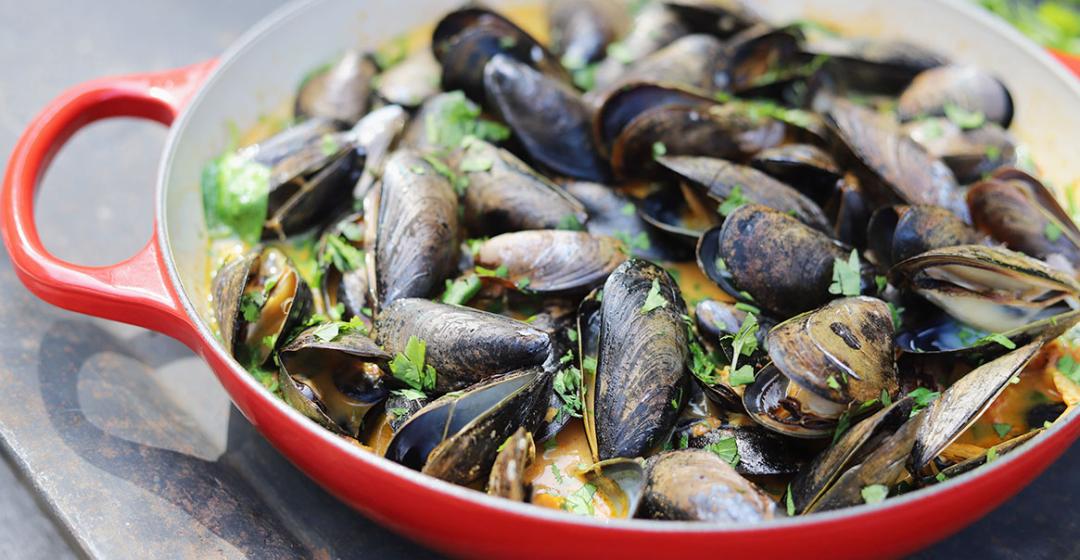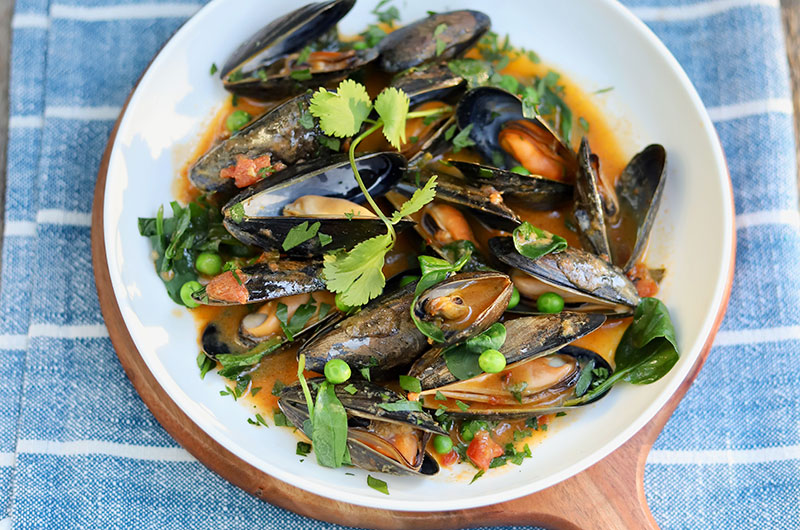If you are prone to prowling craggy coastlines at low tide, testing your sneakers out on slippery rocks and dodging the occasional crashing wave, you have likely encountered wild mussels. And while you could bring a bucket (and maybe a screwdriver) with you on your shoreline sojourns and harvest some of those mussels, it wouldn’t necessarily be advisable or legal unless you had a shellfish license for that town and permission to patrol the property you’re on. You’d also want to be reasonably sure of the inherent cleanliness of the water surrounding the rocks (or pilings) your mussels were clinging to. Mussels are extremely efficient water filters, which means they can gobble up bacteria as well as plankton.
I did exactly none of this the first time I gathered wild mussels in Menemsha about two weeks after I arrived on the Vineyard fifteen years ago. I blame the trespassing on the young fellow I was enthusiastically following around on a “back-roads” tour of the Vineyard. He was an Island native and eager to show me the beauty and the bounty of his home, especially the hidden parts that probably would have taken a newbie like me a decade to discover. I was grateful for the many new ways I got to see the Island that day, even though there were barbed wire fences and cow pies involved – and, apparently, illegal shellfishing. I cooked my mussels with plenty of garlic that night with no untoward consequences. I served them with the wild watercress we had foraged too.
But since then, I’ve been getting my mussels from Canada and Maine (and occasionally Massachusetts) via Vineyard seafood stores. While mussel farming hasn’t taken off here on our Island, up in Prince Edward Island (PEI) in Canada, mussel farms (ropes suspended from rafts or buoys in deep cold water) abound. In fact, these bivalve mollusks love cold temps so much that winter harvesting can involve cracking a layer of ice to get to them.
You will not have to do any of that hard work since Island (and off-Island) seafood stores carry PEI mussels during all the sweater-wearing months. Often, they have Maine mussels too, which Everett Whiting of the Fish House in Edgartown told me he prefers over the Canadian bivalves. He especially likes the Moosabec mussels from Jonesport, Maine, which tend to be a bit bigger than the PEI mussels. The Net Result in Vineyard Haven also gets Moosabec mussels, in addition to PEIs. Folks at Edgartown Seafood told me that they also occasionally get mussels in from Cape Cod once the water temperature drops. All of these mussels, regardless of the provenance, are blue mussels, or Mollusca Bivalvia Mytilus edulis. And they happen to be about the least expensive seafood you can buy; for your thrifty efforts you are rewarded with a good source of protein, Omega-3 fatty acids, zinc, selenium, and vitamin B12.
It’s worth noting that farmed mussels usually undergo thorough cleaning before they get to you, so you will likely only have to give them a good rinse and perhaps a light scrub. You might find a beard or two, which you can simply tug off. The beard, or byssus thread, is a collection of elastic fibers that mussels fabricate to attach themselves to solid objects; the fibers originate from the foot inside the mussel shells.
While you rinse your mussels, notice if any are not closed. Wide open mollusks should be discarded as they are likely dead. But ones that are gaping a bit will probably close up if you give them a rap or a tap. Similarly, when you cook your mussels, they should all open. Stubbornly closed ones should be discarded.
That leaves you with only the hard decision of how to cook your mussels. Actually, the cooking part is easy. Steam-simmering (cooking in a covered pot in a shallow amount of broth) is the quickest way to get your mussels open so they don’t overcook. As a bonus, they release their liquid into the broth in the pot. No, the hard part is choosing a flavor profile for said broth. Mussels are cooked and eaten all over the world; hence a surfeit of classic mussel dishes to inspire you, from moules marinière to mussels marinara, Chinese mussels in black bean sauce to Thai curry mussels and Moroccan mussels in spicy tomato sauce.
The sweet, briny flavor of mussels demands an acidic ingredient – anything from white wine to lime juice will do – and a hit of heat or spice, such as fresh or pickled peppers or chiles, hot sauces, or strong spices, such as saffron and all the curry players. Alliums, such as leeks, shallots, and, of course, garlic, are aromatics that bring an earthy backbone to the cooking broth. Curiously, mussels are also often served in creamy broths – not heavy cream sauces, but broths that may have some cream or coconut milk included or splashed in at the end. A generous amount of herbs and a side of crusty bread (or even croutons on top) make a mussel dish feel complete.
Keeping all these things in mind, I find that one of my favorite cooking broths for mussels is a light Indian curry that has both crushed tomatoes and coconut milk in it (an Indian “pink” sauce, if you will). Onions, garlic, ginger, chili sauce, lime juice, lime zest, and cilantro add all the right notes to play with the mussels. This broth is equally good with shrimp or chicken in it, too, so you’ll be glad to have it in your repertoire.
Serve the curried mussels with warm naan on the side for dipping in the broth. And thank your fishmonger for a culinary adventure without the trespassing.








